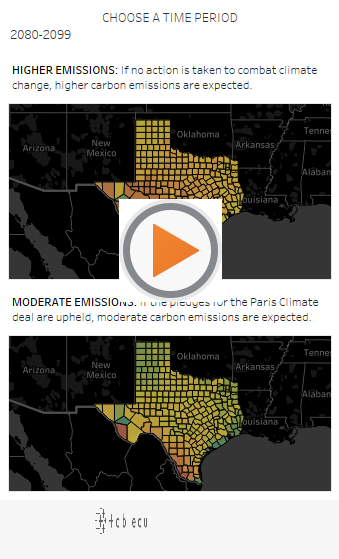By the end of the century, if no action is taken on climate change, some parts of Texas could experience 95-degree temperatures for nearly half the year, including the Rio Grande Valley.
The record-breaking heat wave of 2011 scorched much of Texas — severe heat sent thousands to the emergency room, drought cost agriculture billions of dollars and soaring temperatures tested the power grid.
Houston temperatures soared to 95 degrees Fahrenheit or above for 108 days, far surpassing the historical yearly average of 31 days between 1981 and 2010. The sweltering summer heat wave seemed to be an anomaly.
But according to a new analysis from the Climate Impact Lab, by the end of the century, climate change could cause Texas summers to look more and more like 2011.
In Texas, from 1981 to 2010, an average of 43 days per year had temperatures of at least 95 degrees. By the end of the century, that’s expected to increase to 94 days per year, on average, assuming moderate climate action — like the Paris Climate agreement pledges — is taken.
In Houston, the number is expected to jump from a historical average of 31 days to 90 days — adding two more months of extreme temperature to an already blistering summer.
How much hotter can Texas counties get?
By the end of the century, if no action is taken on climate change, some parts of Texas could experience 95-degree temperatures for nearly half the year. Choose a time period from the menu and hover over the map for details on the number of “hot days” in Texas counties based on moderate emissions and higher emissions projections from the Climate Impact Lab.
Note: The map reflects median (50th percentile) values. Source: Climate Impact Lab
Created by Data Journalist Rachael Gleason | Houston Chronicle
How much hotter can Texas counties get?
By the end of the century, climate change could cause Texas summers to look more and more like drought-stricken 2011, according to a new analysis from the Climate Impact Lab. Compare the number of days with temperatures greater than 95 degrees in Texas counties based on moderate emissions and higher emissions projections. Choose a time period from the menu and hover over the map for details.
Note: The map reflects median (50th percentile) values. Source: Climate Impact Lab
Created by Data Journalist Rachael Gleason | Houston Chronicle
If emissions continue to rise throughout the 21st century, and countries make no effort to curb climate change, the resulting impact could be even more grim, the analysis suggests.
Under a high-emissions scenario, Texans will likely see 106 to 161 of these extreme heat days, with a 1-in-20 chance of more than 186 days reaching 95 degrees, or more than half the year.
With added humidity — which hampers the body’s ability to cool down — the extreme temperatures will feel much worse, and, in some cases, could be life-threatening.
WARMING UP: How hot could climate change make Houston by 2100?
Currently, Texas experiences about seven days per year, on average, that are both so hot and humid that outdoor activity becomes dangerous, with the possibility of heat exhaustion and heat stroke.
By the end of the century, this number will triple, resulting in 20 to 30 of these dangerous days a year, according to James Rising, a postdoctoral fellow at University of California at Berkeley who coauthored the study.
Translator
To read this article in one of Houston’s most-spoken languages, click on the button below.
Subscribe
Get Gray Matters sent to your inbox. Sign up now!
“That will mean there will be around a full month in Texas where it will be dangerous to do outdoor labor or even enjoy a short periods of going outside,” Rising said.
The increase in temperatures accompanying climate change will mean more than just uncomfortably hot days. In a study published in June in the journal Science, researchers measured the economic impact climate change had on a number of factors, including agriculture, crime, energy demands and labor productivity.
Researchers estimated that the Texas economy will be among the states hardest hit, likely seeing a loss of 3.4 to 9.5 percent of Gross State Product per year beginning in 2080.
Harris County could face damages worth up to 6 percent of median income a year beginning in 2080. Some counties in Texas could fare much worse, facing damages up to 20 percent of median income—ranking them among the worst hit counties in the nation.
“The weather affects us in millions of tiny ways that people can’t imagine,” said Andrew Dessler, a professor of atmospheric sciences at Texas A&M. “You can always say we will adapt, but it could be very expensive. It’s going to cost us money, and it’s going to change the way we live.”
Bookmark Gray Matters. It hampers the body’s ability to cool down.













